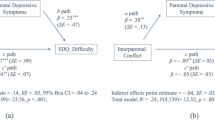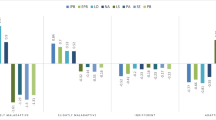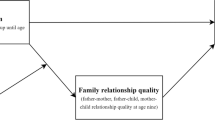Abstract
Objectives
This study aimed to explore family origins of adolescent dysfunctional separation-individuation. We tested the fit of a theoretical model in which mothers’ parenting stress and adolescents’ perceived maternal psychological control were specified as mediators between mothers’ marital satisfaction and adolescent dysfunctional separation–individuation.
Methods
Participants were 276 adolescents (aged 12–15 years old) and their mothers. Adolescents completed measures of perceived maternal psychological control and dysfunctional separation–individuation, and mothers completed measures of marital satisfaction and parenting stress.
Results
The association between mothers’ marital satisfaction and adolescents’ dysfunctional dependence was both direct and serially mediated through mothers’ parenting stress and adolescents’ perceived maternal dependency-oriented psychological control (β = −0.02, p < 0.05, 95% CI = [−0.04, −0.002]). Parenting stress was associated with dysfunctional dependence through perceived dependency-oriented psychological control (β = 0.06, p < 0.05, 95% CI = [0.01, 0.10]) while being associated with dysfunctional independence through perceived achievement-oriented psychological control (β = 0.05, p < 0.05, 95% CI = [0.01, 0.10]). Parenting stress also served as the mediator in the association between marital satisfaction and perceived dependency-oriented psychological control (β = −0.06, p < 0.05, 95% CI = [−0.11, −0.01]), and in the association between marital satisfaction and perceived achievement-oriented psychological control (β = −0.06, p < 0.05, 95% CI = [−0.11, −0.001]).
Conclusions
The current study extended past findings by identifying mothers’ marital satisfaction as a contributor to adolescent dysfunctional separation–individuation, and parenting stress and adolescents’ perceived maternal psychological control as mediating mechanisms.


Similar content being viewed by others
Data Availability
We have joined the Peer Reviewers’ Openness Initiative and made our study data open and transparent. Please see https://doi.org/10.17632/dp4gjf4rht.1.
References
Abidin, R. (1992). The determinants of parenting behavior. Journal of Clinical Child Psychology, 21, 407–412.
Bao, X. H., & Lam, S. F. (2008). Who makes the choice? Rethinking the role of autonomy and relatedness in Chinese children’s motivation. Child Development, 79, 269–283.
Barber, B. K. (1996). Parental psychological control: revisiting a neglected construct. Child Development, 67, 3296–3319.
Belsky, J. (1984). The determinants of parenting: a process model. Child development, 55, 83–96.
Berry, J. O., & Jones, W. H. (1995). The parental stress scale: initial psychometric evidence. Journal of Social & Personal Relationships, 12, 463–472.
Blos, P. (1967). The second individuation process of adolescence. Psychoanalytic Study of the Child, 22, 162–186.
Chen, L., Wu, X., & Liu, C. (2014). The relationship between marital satisfaction and father involvement: the mediation effect of coparenting. Psychological Development & Education, 3, 268–276.
Cheung, C. S., & Pomerantz, E. M. (2011). Parents’ involvement in children’s learning in the United States and China: implications for children’s academic and emotional adjustment. Child Development, 82, 932–950.
Coln, K. L., Jordan, S. S., & Mercer, S. H. (2013). A unified model exploring parenting practices as mediators of marital conflict and children’s adjustment. Child Psychiatry & Human Development, 44, 419–29.
Cox, M. J., & Paley, B. (1997). Families as systems. Annual Review of Psychology, 48, 243–267.
Deater-Deckard, K. (2004). Parenting stress. New Haven, CT: Yale University Press.
Deci, E. L., & Ryan, R. M. (2000). The” what” and” why” of goal pursuits: human needs and the self-determination of behavior. Psychological Inquiry, 11, 227–268.
Delhaye, M., Kempenaers, C., Burton, J., Linkowski, P., Stroobants, R., & Goossens, L. (2012). Attachment, parenting, and separation–individuation in adolescence: a comparison of hospitalized adolescents, institutionalized delinquents, and controls. Journal of Genetic Psychology, 173, 119–141.
Downing, H. M., & Nauta, M. M. (2010). Separation-individuation, exploration, and identity diffusion as mediators of the relationship between attachment and career indecision. Journal of Career Development, 36, 207–227.
Flowers, B. J., & Olson, D. H. (1993). ENRICH marital satisfaction scale. Journal of Family Psychology, 7, 176–185.
Grolnick, W. S., Price, C. E., Beiswenger, K. L., & Sauck, C. C. (2007). Evaluative pressure in mothers: effects of situation, maternal, and child characteristics on autonomy supportive versus controlling behavior. Developmental Psychology, 43, 991–1002.
Guisinger, S., & Blatt, S. J. (1994). Individuality and relatedness: evolution of a fundamental dialectic. American Psychologist, 49, 104–111.
Haws, W. A., & Mallinckrodt, B. (1998). Separation-individuation from family of origin and marital adjustment of recently married couples. American Journal of Family Therapy, 26, 293–306.
Hu, L., & Bentler, P. M. (1999). Cutoff criteria for fit indexes in covariance structure analysis: conventional criteria versus new alternatives. Structural Equation Modeling, 6, 1–55.
Huth-Bocks, A. C., & Hughes, H. M. (2008). Parenting stress, parenting behavior, and children’s adjustment in families experiencing intimate partner violence. Journal of Family Violence, 23, 243–251.
Jeong, Y., & Chun, Y. (2010). The pathways from parents’ marital quality to adolescents’ school adjustment in South Korea. Journal of Family Issues, 31, 1604–1621.
Jiang, L. C., Yang, I. M., & Wang, C. J. (2016). Self-disclosure to parents in emerging adulthood: examining the roles of perceived parental responsiveness and separation-individuation. Journal of Social and Personal Relationships, 34, 425–445.
Kins, E., Beyers, W., & Soenens, B. (2013). When the separation-individuation process goes awry: distinguishing between dysfunctional dependence and dysfunctional independence. International Journal of Behavioral Development, 37, 1–12.
Kins, E., Soenens, B., & Beyers, W. (2012). Parental psychological control and dysfunctional separation–individuation: a tale of two different dynamics. Journal of Adolescence, 35, 1099–1109.
Kruse, J., & Walper, S. (2008). Types of individuation in relation to parents: predictors and outcomes. International Journal of Behavioral Development, 32, 390–400.
Levine, J. B., Green, C. J., & Millon, T. (1986). The separation–individuation test of adolescence. Journal of Personality Assessment, 50, 123–137.
Lin, X., Zhang, Y., Chi, P., Ding, W., Heath, M. A., Fang, X., & Xu, S. (2017). The mutual effect of marital quality and parenting stress on child and parent depressive symptoms in families of children with oppositional defiant disorder. Frontiers in Psychology, 8, 1810–1821.
Liu, Y., Deng, H., Zhang, G., Liang, Z., & Lu, Z. (2015). Association between parenting stress and child behavioral problems: the mediation effect of parenting styles. Psychological Development & Education, 31, 219–326.
Louie, A. D., Cromer, L. D., & Berry, J. O. (2017). Assessing parenting stress: review of the use and interpretation of the Parental Stress Scale. Family Journal, 25, 359–367.
Lynch, M., & Cicchetti, D. (2002). Links between community violence and the family system: evidence from children’s feelings of relatedness and perceptions of parent behavior. Family Process, 41, 519–532.
Mabbe, E., Soenens, B., Vansteenkiste, M., van der Kaap-Deeder, J., & Mouratidis, A. (2018). Day-to-day variation in autonomy-supportive and psychologically controlling parenting: the role of parents’ daily experiences of need satisfaction and need frustration. Parenting-Science and Practice, 18, 86–109.
Mahler, M. S., Pine, F., & Bergman, A. (1975). The psychological birth of the human infant. New York: Basic Books.
Mattanah, J. F., Hancock, G. R., & Brand, B. L. (2004). Parental attachment, separation-individuation, and college student adjustment: a structural equation analysis of mediational effects. Journal of Counseling Psychology, 51, 213–225.
Mayseless, O., & Scharf, M. (2009). Too close for comfort: Inadequate boundaries with parents and individuation in late adolescent girls. American Journal of Orthopsychiatry, 79, 191–202.
Osborne, L. A., & Reed, P. (2010). Stress and self-perceived parenting behaviors of parents of children with autistic spectrum conditions. Research in Autism Spectrum Disorders, 4, 405–414.
Oudekerk, B. A., Allen, J. P., Hessel, E. T., & Molloy, L. E. (2014). The cascading development of autonomy and relatedness from adolescence to adulthood. Child Development, 86, 472–485.
Preacher, K. J., Rucker, D. D., & Hayes, A. F. (2007). Addressing moderated mediation hypotheses: theory, methods, and prescriptions. Multivariate Behavioral Research, 42, 185–227.
Qin, L., Pomerantz, E. M., & Wang, Q. (2009). Are gains in decision-making autonomy during early adolescence beneficial for emotional functioning? The case of the United States and China. Child Development, 80, 1705–1721.
Robinson, M., & Neece, C. L. (2015). Marital satisfaction, parental stress, and child behavior problems among parents of young children with developmental delays. Journal of Mental Health Research in Intellectual Disabilities, 8, 23–46.
Rolan, E. P., Schmitt, S. A., Purpura, D. J., & Nichols, D. L. (2018). Sibling presence, executive function, and the role of parenting. Infant & Child Development, 27, 2091.
Scharf, M., & Goldner, L. (2018). “If you really love me, you will do/be…”: Parental psychological control and its implications for children’s adjustment. Developmental Review, 49, 16–30.
Schoppe-Sullivan, S., Schermerhorn, A., & Cummings, E. M. (2007). Marital conflict and children’s adjustment: evaluation of the parenting process model. Journal of Marriage & Family, 69, 1118–1134.
Schramm, D. G., & Adler-Baeder, F. (2012). Marital quality for men and women in stepfamilies: examining the role of economic pressure, common stressors, and stepfamily-specific stressors. Journal of Family Issues, 33, 1373–1397.
Sheldon, K. M., & Gunz, A. (2009). Psychological needs as basic motives, not just experiential requirements. Journal of Personality, 77, 1467–1492.
Shu, Z., Qiong, H., Li, X., Zhang, J., Zhang, Y., & Fang, X. (2016). Effect of maternal stress on preschoolers’ creative personality: the mediating role of mothers’ parenting styles. Psychological Development & Education, 32, 276–284.
Soenens, B., Vansteenkiste, M., & Luyten, P. (2010). Toward a domain-specific approach to the study of parental psychological control: distinguishing between dependency-oriented and achievement-oriented psychological control. Journal of Personality, 78, 217–256.
Steeger, C. M., & Gondoli, D. M. (2013). Mother–adolescent conflict as a mediator between adolescent problem behaviors and maternal psychological control. Developmental Psychology, 49, 804–814.
Stey, P. C., Hill, P. L., & Lapsley, D. (2014). Factor structure and psychometric properties of a brief measure of dysfunctional individuation. Assessment, 21, 452–462.
van der Kaap-Deeder, J., Vansteenkiste, M., Soenens, B., Loeys, T., Mabbe, E., & Gargurevich, R. (2015). Autonomy-supportive parenting and autonomy-supportive sibling interactions: the role of mothers’ and siblings’ psychological need satisfaction. Personality and Social Psychology Bulletin, 41, 1590–1604.
Wong, W. C. W., Chen, W. Q., Goggins, W. B., Tang, C. S., & Leung, P. W. (2009). Individual, familial and community determinants of child physical abuse among high-school students in China. Social Science and Medicine, 68, 1819–1825.
Xiang, S., & Liu, Y. (2018). Understanding the joint effects of perceived parental psychological control and insecure attachment styles: a differentiated approach to adolescent autonomy. Personality and Individual Differences, 126, 12–18.
Xing, S., Gao, X., Song, X., Archer, M., Zhao, D., Zhang, M., Ding, B., & Liu, X. (2017). Chinese preschool children’s socioemotional development: the effects of maternal and paternal psychological control. Frontiers in Psychology, 8, 1818.
Author Contributions
SXi: designed and carried out experiments, analyzed experimental results, created database, conducted data analyses, wrote the paper. YLi: collaborated with the design, writing and data analysis of the study. YLu: collaborated with the design, carried out experiments, assisted with the creation of the database. LB and SXu: assisted with literature review, carried out experiments, assisted with the creation of the database.
Funding
This work was supported by the Fundamental Research Funds for the Central Universities (2012WYB16) and the MOE Project of Key Research Institutes of Humanities and Social Science at Universities (16JJD880007).
Author information
Authors and Affiliations
Corresponding author
Ethics declarations
Conflict of Interest
The authors declare that they have no conflict of interest.
Ethics Approval
All participants were treated according to APA ethical standards, and this study was approved by the Ethics Committee of the School of Psychology, Beijing Normal University.
Informed Consent
Informed consent was received from every adolescent’s mother included in the study.
Additional information
Publisher’s note Springer Nature remains neutral with regard to jurisdictional claims in published maps and institutional affiliations.
Rights and permissions
About this article
Cite this article
Xiang, S., Liu, Y., Lu, Y. et al. Exploring the family origins of adolescent dysfunctional separation–individuation. J Child Fam Stud 29, 382–391 (2020). https://doi.org/10.1007/s10826-019-01644-w
Published:
Issue Date:
DOI: https://doi.org/10.1007/s10826-019-01644-w




